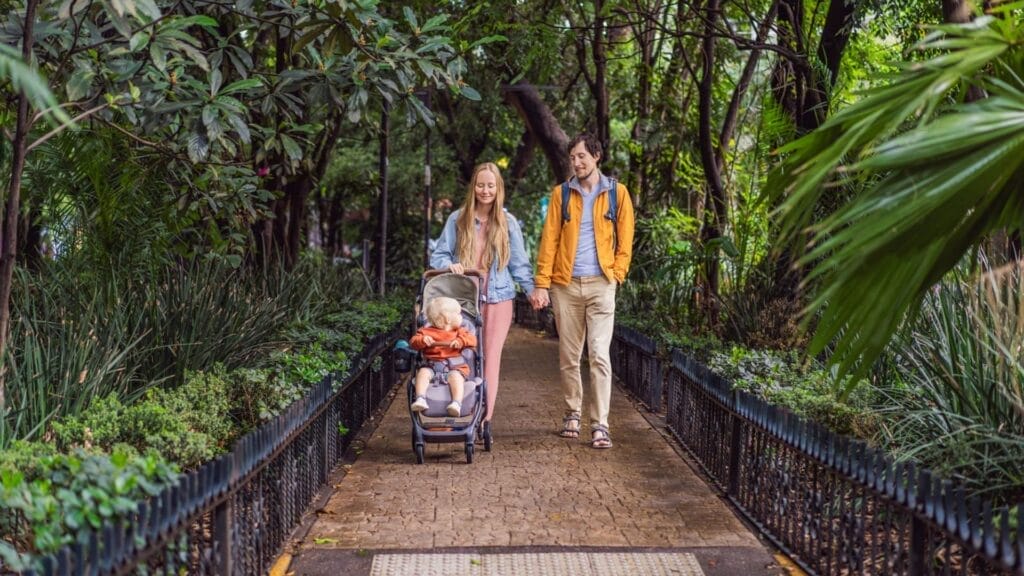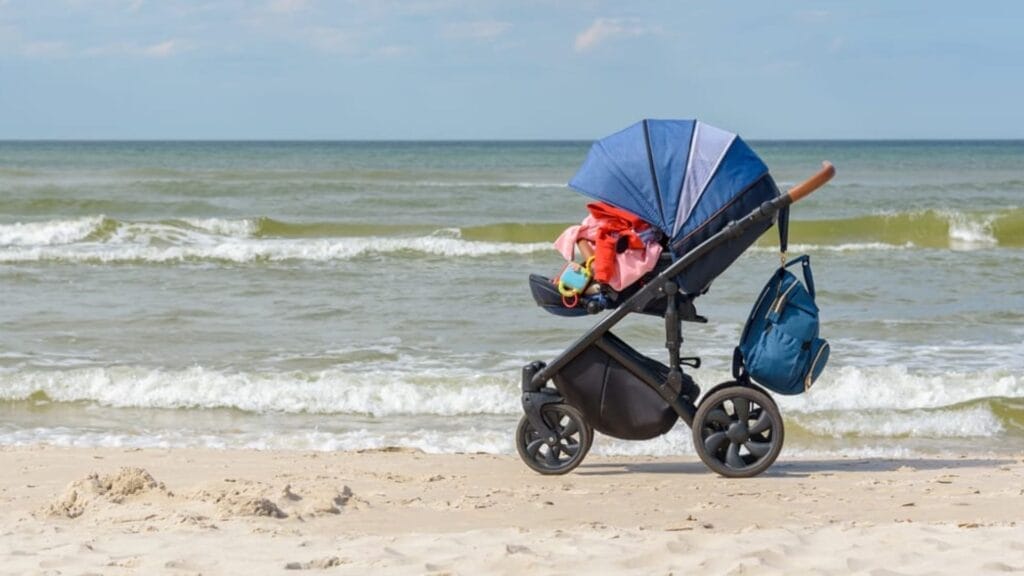Baby Carrier vs Stroller: Which is Best for Traveling Parents?
Traveling with a baby or toddler can be an adventure filled with equal parts excitement and challenges. Between diaper changes, nap schedules, and navigating unfamiliar places, parents quickly learn that having the right gear isn’t just a convenience—it’s a necessity. When it comes to getting around smoothly, baby carrier vs. stroller for travel is one of the biggest decisions you’ll face.
Both strollers and baby carriers have earned their place as essential travel companions, each offering unique perks. The stroller provides a cozy ride for your little one and extra storage space for all those must-have items. The baby carrier, on the other hand, offers hands-free freedom and closeness that’s hard to beat.
This guide dives into the nitty-gritty of both options. It’s designed to help you figure out which setup suits your trip style, your baby’s needs, and your sanity best. Whether you’re hopping on planes, exploring city streets, or trekking through nature trails, understanding these tools will make traveling with a baby feel less like a juggling act and more like a breeze.
If you’re considering some international travel, Europe could be a fantastic option with your little one. Here are 5 best toddler-friendly destinations in Europe that you might want to explore. And don’t forget about baby travel products latest deals and discounts, ensuring your baby’s comfort while also saving big on essential gear like a travel system.
Understanding Baby Carriers and Strollers: Basics and Benefits
When deciding whether to use a baby carrier or use a stroller, it helps to get clear on what each option really is—and what it brings to the parenting table.
What’s a Baby Carrier?
Baby carriers come in a few styles:
- Wraps: Long pieces of fabric you wrap around your body to hold your baby close.
- Soft Structured Carriers (like the popular LÍLLÉbaby Complete): These have padded straps, buckles, and ergonomic designs for comfort and support.
Using a baby carrier means your little one stays snug against you, which brings some serious perks:
- Hands-free convenience. Your arms are free to juggle bags, grab coffee, or hold an older sibling’s hand.
- Lightweight portability. Most carriers fold up small enough for a diaper bag or backpack.
- Bonding through babywearing. Babies love being close—it calms them down and boosts attachment.
- Ease in crowded or uneven terrain. No worries about stroller wheels getting stuck on cobblestones, stairs, or packed sidewalks when you opt for baby wearing.
What’s a Stroller?
Strollers cover a range of styles too:
- Travel strollers: Lightweight, easy to fold—built for jet-setting parents.
- Umbrella strollers: Super compact and perfect for quick trips.
- Jogging strollers: Designed with sturdy wheels and suspension for active outings.
Strollers bring their own set of wins:
- Storage space. Finally! A place for that diaper bag, snacks, toys, water bottles—you name it.
- Sun protection with canopies. Keeps your baby shaded from harsh rays during long walks.
- Comfort for longer naps on-the-go. Reclining seats and cushy padding make napping outside the crib easier.
Deciding between baby carriers for travel or strollers depends on what fits your trip style and your child’s needs best. Some parents find that combining both covers all the bases—carrier for busy airports and crowded spots, stroller when it’s time to lounge or haul gear around town.
Pros and Cons of Using a Baby Carrier for Travel
Using baby carrier comes with a unique set of pros and cons that can make or break your travel experience. If you’re trying to decide whether to use a baby carrier on your next trip, here’s what you need to know.

Pros:
- Lightweight and Compact: Baby carriers fold down small and fit easily into a carry-on or backpack. No bulky gear taking up precious space.
- Perfect for Airports/Security Checks: Glide through security without the hassle of folding strollers or gate-checking. Your baby stays snug against you, no need to remove them during screenings.
- Great for Stairs and Public Transport: Navigating subway stairs or crowded buses is way easier when you carry your baby. No lugging a stroller up ramps or squeezing through narrow aisles.
- Promotes Bonding: Close skin-to-skin contact calms babies and keeps them engaged with you. It’s like having your little travel buddy right there all day.
- Ideal for Newborns: Many carriers support newborns well, providing ergonomic support and comfort from day one.
- Crowd-Friendly: Tight markets, festivals, or busy museums? Baby carriers keep you nimble where strollers might get stuck.
Cons:
- Physical Strain: Carrying your baby all day can get tiring on your back, shoulders, and hips. Good posture and breaks are essential.
- Limited Storage Space: Unlike strollers, carriers don’t have baskets for diaper bags or snacks—you’ll need a separate bag.
- Sun/Rain Protection Challenges: Most carriers don’t come with built-in weather shields. Rain covers are available but add another item to manage.
- Potential Boredom for Older Toddlers: Once they want to explore on foot, being strapped in can frustrate toddlers who crave independence.
- Requires Practice: Learning how to wear the carrier comfortably takes time. Trying it out at home before hitting the road saves headaches.
Choosing to use a baby carrier means embracing hands-free convenience and closeness, balanced against physical demands and storage limitations. This mix shapes whether it fits your travel style best.
Pros and Cons of Using a Stroller for Travel
When deciding between a baby carrier vs. stroller for travel, pushing a stroller brings several practical perks that many parents appreciate:

Advantages of Using a Stroller for Travel
- Shade and sun protection: Most strollers come with adjustable canopies that shield your little one from harsh sunlight, a must-have during long outdoor excursions or beach days.
- Ample storage: Under-seat baskets and built-in compartments offer plenty of room for diaper bags, snacks, toys, and even souvenirs picked up along the way—no need to carry everything on your back.
- Comfortable napping spot: Toddlers can nap comfortably in reclined seats, giving you freedom to explore without worrying about disturbing their sleep.
- Feeding ease: Toddler strollers often feature snack trays or cup holders, making on-the-go feeding less messy and more convenient during sightseeing or errands.
- Long walks-friendly: Pushing a stroller is ideal for covering longer distances without tiring your arms or back, especially when the little one prefers walking less or needs breaks.
On the flip side, strollers have their drawbacks that can complicate travel logistics:
Disadvantages of Using a Stroller for Travel
- Bulkiness: Even lightweight travel strollers take up space and add weight to your luggage haul.
- Airport hassles: Folding requirements at security checkpoints can slow you down, plus gate-checking or carrying the stroller through crowded terminals isn’t always simple.
- Risk of damage or loss: Checked strollers can get banged up or misplaced by airlines.
- Limited access in tight spaces: Narrow streets, museums, historic sites, or crowded public transport might force you to abandon the stroller temporarily.
- Uneven terrain struggles: Cobblestones, hiking trails, or sandy paths quickly reveal a stroller’s limits compared to nimble baby carriers.
Choosing to use the stroller depends heavily on trip specifics—distance walked, terrain type, and how much gear you need to carry. In many cases, combining both options helps parents travel smarter by playing to each gear’s strengths.
Comparing Baby Carrier vs Stroller for Different Travel Scenarios
When it comes to traveling with your little one, choosing between a baby carrier and a stroller can greatly impact convenience and comfort. Each option has its own advantages depending on the specific travel scenario you’re in. Let’s explore how these two travel essentials stack up against each other for different situations.
1. Newborn Travel
For parents who are traveling with a newborn, having both a soft infant carrier and a lightweight travel stroller can offer maximum flexibility. Here’s how each option can benefit your travels:
- Soft Infant Carrier: This type of carrier allows you to keep your newborn close while on the move. It’s perfect for situations where you need to navigate through crowded places or when you want to bond with your baby during walks.
- Lightweight Travel Stroller: An infant travel stroller provides the necessary support for longer walks or airport navigation. It offers a comfortable seat for your baby to relax in while you push them along.
In addition to these two essentials, it’s also important to consider what items you’ll need when traveling with an infant. Packing wisely can greatly enhance the overall travel experience by ensuring you have all necessary items readily available.
2. Toddler Travel
When it comes to traveling with toddlers, the choice between carriers and strollers depends on their walking stamina and your sightseeing plans. Here are some options to consider:
- Toddler Carriers: If your toddler enjoys exploring on foot but tires easily, a toddler carrier can offer a hands-free option while providing comfort and security. This way, you can continue with your activities without worrying about carrying them all the time.
- Double Strollers: For outings where both little ones need a break or nap, double strollers come in handy. They allow you to transport two children comfortably without disrupting their sleep patterns.
3. Urban Trips vs Hiking Holidays
The type of terrain you’ll be navigating also plays a role in deciding between carriers and strollers:
- Urban Settings: In cities or urban areas with smooth pavements, strollers might be more practical due to their ease of maneuvering through crowded streets. You can effortlessly push your stroller while exploring shops, restaurants, and parks.
- Hiking Holidays: For outdoor adventures such as hiking trips, hiking backpack carriers or toddler carriers are ideal choices. These options offer better mobility in rugged terrains where strollers may struggle.
By considering the specific needs and demands of each travel scenario, parents can make informed decisions on whether to rely more on baby carriers or strollers. This way, they can ensure a smooth and enjoyable experience for both themselves and their little ones.
Weather Considerations When Choosing Between Carrier or Stroller While Traveling
Picking between a baby carrier and stroller depends a lot on the weather where you’re headed. Using baby carrier in warm climates calls for keeping your little one cool and comfy, while using stroller in warm climates offers a bit more protection and storage for all those sun essentials.

Warm Climates & Beach Destinations
- Strollers with sun canopies are lifesavers, offering shade that baby carriers just can’t provide.
- Ample ventilation matters—look for strollers with breathable mesh panels to keep air flowing.
- Extra storage space: sunscreen, diapers, snacks—all the must-haves fit easily without weighing you down.
- Baby carriers need to be lightweight and made of breathable fabric; some come with mesh inserts to help prevent overheating.
Cold Climates
- Layering is your best friend when using a baby carrier: think baby-wearing jacket styles that zip around both you and your baby.
- Strollers shine here with bunting bags or insulated covers that keep babies snug while you explore.
- Don’t forget weatherproof mittens, hats, and blankets no matter which gear you bring.
Rain & Weather Accessories
Weather isn’t always predictable. Rain covers made specifically for strollers or baby carriers can save the day—and your trip. These accessories shield your baby from wet conditions without sacrificing comfort or visibility.
The right gear plus smart weather accessories make traveling smoother, safer, and way more enjoyable for both you and your little one.
Feeding and Napping On-the-Go: Carrier vs Stroller
When it comes to feeding and napping your little one while you’re out and about, both carriers and strollers have their advantages. Let’s take a closer look at how each option can cater to your baby’s needs.

Benefits of Breastfeeding with a Carrier
Using a carrier can be a game-changer for breastfeeding moms. Here are some benefits:
- Hands-free nursing: With a carrier, you can nurse your baby without using your hands. This allows you to multitask and attend to other activities while keeping your little one close.
- Discreet outings: If you prefer to breastfeed discreetly in public, a carrier provides the perfect solution. You can easily cover yourself with a scarf or blanket while nursing, ensuring privacy during outings.
Feeding Solid Food with a Stroller Tray
As your baby transitions to solid foods, mealtime on-the-go becomes more challenging. Here’s where toddler travel strollers equipped with trays come in handy:
- Convenient feeding stops: When you’re out exploring or running errands, finding a suitable place to feed your toddler can be difficult. With a stroller tray, you can easily pull over at rest stops or parks and feed your little one without any hassle.
- Mess-free meals: Feeding toddlers can get messy! Having a designated tray in the stroller makes cleanup easier as you can simply wipe it down after each meal.
Napping Considerations: Carrier vs Stroller
Naptime is crucial for babies, and different sleep environments work for different infants. Here’s what you need to know:
- Reclined position in strollers: Many babies sleep better when reclined during naps. If your little one prefers this position, using a stroller with adjustable seating might be beneficial.
- Comfort of being close in carriers: Some infants find solace in being close to their caregivers while sleeping. If your baby enjoys the snugness of a carrier, wearing them during walks or outings could help them drift off peacefully.
Understanding these feeding and napping dynamics will empower you as a parent on-the-go! Whether you choose to use a carrier or stroller for these activities ultimately depends on what works best for you and your baby.
Packing Tips & Renting Options for Traveling Parents
Efficient Packing Strategies
- When bringing both a stroller and a baby carrier, opt for compact diaper bags or backpack diaper bags to minimize luggage bulk.
- Utilize compartments and organizers within your bags to keep essentials easily accessible while on the move.
Renting Strollers at Destinations
- Consider renting strollers at your destination for international trips to lighten your travel load.
- Research rental options beforehand to ensure availability and quality of strollers at your destination.
By packing smartly and exploring renting options, traveling parents can streamline their journey and focus more on creating lasting memories with their little ones.
Safety Guidelines & Expert Tips For Using Carriers And Strollers During Travel
Keeping safety front and center when deciding between a baby carrier vs. stroller for travel makes all the difference in peace of mind. Here are some key reminders and expert tips to help you make smart, safe choices on the go:
- Avoid loose fabric near baby’s face in carriers. This prevents accidental suffocation or overheating. Always check that wraps or slings are snug but breathable, with no material covering your baby’s nose or mouth.
- Don’t hang heavy bags on stroller handles. It might seem convenient, but extra weight can tip the stroller backward, risking injury. Use under-seat storage or specially designed stroller hooks instead.
- Choose certified gear meeting safety standards for carriers and strollers. Look for labels confirming compliance with ASTM, JPMA, or similar certifications which ensure tested durability and design.
- Adhere strictly to age and weight limits. Carriers must provide proper hip support to prevent developmental issues like hip dysplasia—check that your carrier positions your baby in an “M” shape with knees higher than the bottom.
- Inspect harnesses and brakes on strollers regularly. Secure five-point harnesses keep your child safely strapped in during bumpy rides or sudden stops. Locking brakes prevent runaway strollers on slopes or crowded spots.
- Practice using your carrier at home before travel. Getting comfortable with adjustments, knots, and buckles reduces fumbling nerves while navigating airports or busy streets.
Safety doesn’t just protect your little one; it makes travel smoother for everyone involved. When gear meets the highest standards and you use it wisely, adventures become memories—not mishaps.
Making The Right Choice For Your Family’s Lifestyle And Destination
When planning a trip, there are several factors that can influence your decision on whether to use a carrier or a stroller:
- Trip length/type: Consider the nature of your activities. Are you running errands or going sightseeing? This can impact your choice of transportation for your child.
- Terrain: Think about the type of terrain you’ll be navigating. Will you encounter stairs or rely on public transport? Or will you be visiting parks or malls where a stroller might be more convenient?
- Weather conditions: Take into account the weather forecast for your trip. If it’s expected to be hot or rainy, it may affect your decision on which option to choose.
It’s also important to consider how you can combine both options strategically during your trips:
- Use a carrier in crowded spots or when using public transport
- Opt for a stroller during long walks, shopping excursions, naps, or resting times
By taking these factors into consideration and finding ways to combine both options, you can make the right choice that suits your family’s lifestyle and destination.


